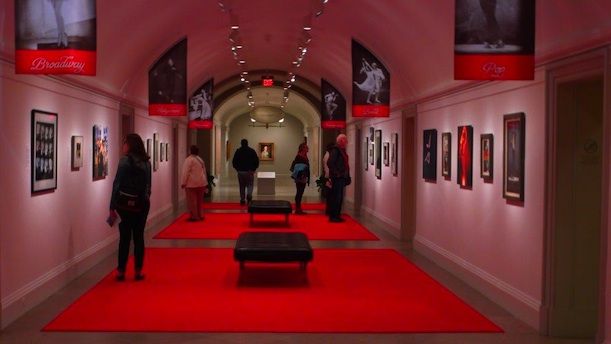What is the Origin of Hollywood’s Red Carpet?
Curator Amy Henderson has rolled out the red carpet to a host of America’s dancing superstars in a new show at the Portrait Gallery
:focal(293x151:294x152)/https://tf-cmsv2-smithsonianmag-media.s3.amazonaws.com/filer/f0/1d/f01d6e6f-3322-4063-9ebb-eda736adb320/fredastairegingerrogers_npg.jpg)
I am an unapologetic fan of show biz glitz. When organizing an exhibition, my approach is to dip scholarship in dazzle: I firmly believe that injecting an exhibition with spectacle and showmanship fuels the path to understanding. The idea is to inspire visitors rather than to intimidate, baffle or bore them. I've always wanted to roll out the red carpet and this time I did.
In the current exhibition, "Dancing the Dream," which recently opened at the National Portrait Gallery, the idea was to show how Broadway, Hollywood, modern, classical and contemporary dance have captured American culture in motion. In 1900, Loie Fuller unleashed her barefoot and uncorseted version of the “New Woman” on stages around the world; in the 1930s, Fred and Ginger danced an elegant escapism for Depression audiences; at the height of the Cold War, Rudolf Nureyev and Mikhail Baryshnikov sought asylum and sparked a mania for ballet in America; from the 1980s to today, MTV and YouTube have showcased such dancers as Michael Jackson and Beyoncé and created audiences that are both more diverse and more individualized than ever before.
/https://tf-cmsv2-smithsonianmag-media.s3.amazonaws.com/filer/0c/8a/0c8a9060-73cf-4ea6-8bf1-f4eb56a325c8/mikhailbaryshnikov_npg.jpg)
The dance exhibition’s basic ingredients—strong images of iconic personalities—were already present, as the Gallery has an extraordinary collection of key dance figures—Isadora Duncan, Irene Castle, Josephine Baker, Busby Berkeley Rita Moreno, Alvin Ailey, Shakira and Justin Timberlake, to name a few. The challenge for the museum’s design team was to create a lively showcase that conveyed dance’s dynamism. “I don’t like white walls,” I chirped. “Make it dazzle.”

And they did. One of the most exciting design elements is the red carpet that runs down the center hall connecting each of the six exhibition rooms. Yes, the National Portrait Gallery has a real red carpet. Designer Raymond Cunningham told me that he researched A-List red carpet events and discovered that the “red” used by the Golden Globes is a bluer red than the brighter hue used for the Academy Awards. The color used for "Dancing the Dream" is close to Oscar’s, but has been uniquely created for the Gallery.
Tibor Waldner, the museum's chief of design, and his remarkable staff created a space that radiates with color—a drawing of Josephine Baker shimmies and shakes in a gallery with stunning teal walls; young ballet dancer Misty Copeland soars as a flaming Firebird in a gallery the color of her fires; Beyoncé hot-steps her “Single Ladies” number in a yellow-green gallery that I call “the riot of Spring.”
I was vastly intrigued by Raymond’s red carpet research, and have since discovered that the red carpet itself has an amazing history. The earliest reference to “walking a red carpet” is in Aeschylus’s Agamemnon in 458 B.C., when the title character is greeted by his vengeful wife Clytemnestra, who invites him to walk a “crimson path” to his house. In Georgetown, South Carolina, a ceremonial red carpet was purportedly rolled out for President James Monroe when he disembarked from a riverboat in 1821. Mainly, though, it seems the red carpet was a railroad phenomenon: in 1902, the New York Central used plush crimson carpets to direct people boarding the 20th Century Limited. It was this usage that seems to mark the origin of the phrase “red carpet treatment.”
Today, we associate red carpets as fashion and celebrity runways at major entertainment events. I asked Linda Mehr, director of the Academy of Motion Pictures’ Margaret Herrick Library, when the Academy began using a red carpet, and she told me that it wasn’t until 1961. Television broadcasts of the Oscars had begun in 1953, and by 1966 when the awards were first broadcast in color, the red carpet had become a major factor in the Oscar experience. Turner Classic Movies primetime host Robert Osborne has said that “for most of us, even a walk down the red carpet is just a dream.” It has also has become the stage for one of the biggest fashion events of the year. At the 2013 Oscars, Jessica Chastain told a reporter that “as a little girl…I always dreamed about my Oscar dress. I love fashion that celebrates a woman’s body, and that maybe is a throwback to the glamour of Old Hollywood.” Amy Adams said of her Oscar de la Renta dress, “I’ve worn a lot of different dresses, but I’ve never worn a big ballgown, so I thought I wanna wear a dress you can’t wear anywhere but the Oscars.”
Many of the iconic figures in the dance exhibition have walked the red carpet: several have won Oscars—including Gene Kelly, James Cagney, Rita Moreno, and Liza Minnelli—and several have been awarded Grammys, including Lady Gaga, Justine Timberlake, and Beyoncé
/https://tf-cmsv2-smithsonianmag-media.s3.amazonaws.com/filer/12/ac/12ac510d-d4df-4135-a966-7f1aeec7f0ab/beyonce_npg.jpg)
Dancing the Dream will be open at the National Portrait Gallery until July 13, 2014.
/https://tf-cmsv2-smithsonianmag-media.s3.amazonaws.com/filer/09/a6/09a6e260-7476-41d4-b3a4-813dbaf94306/amy-henderson_npg1401-2001.jpg)
/https://tf-cmsv2-smithsonianmag-media.s3.amazonaws.com/accounts/headshot/Amy_Henderson_NPG1401.jpg)
/https://tf-cmsv2-smithsonianmag-media.s3.amazonaws.com/accounts/headshot/Amy_Henderson_NPG1401.jpg)